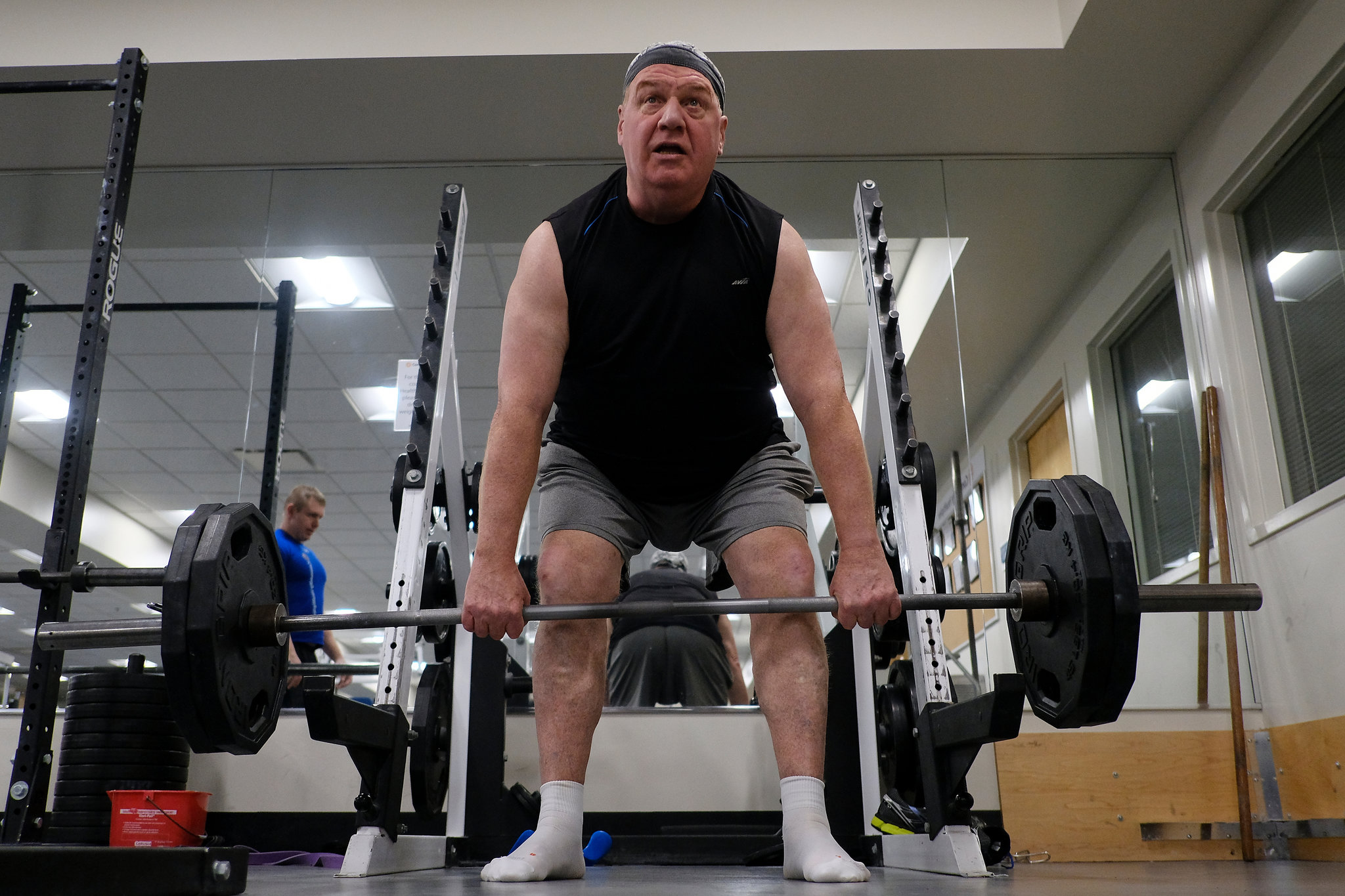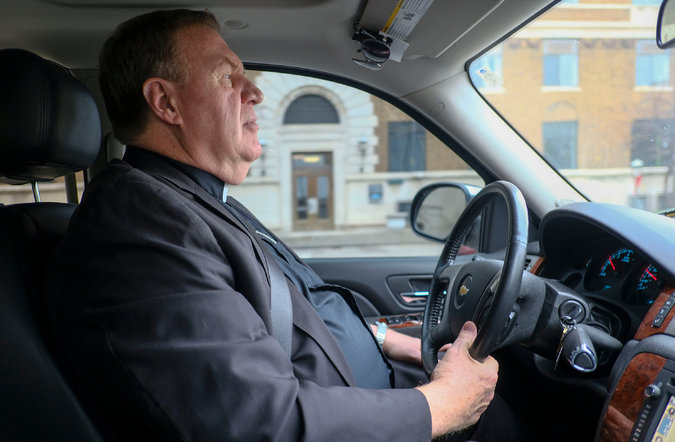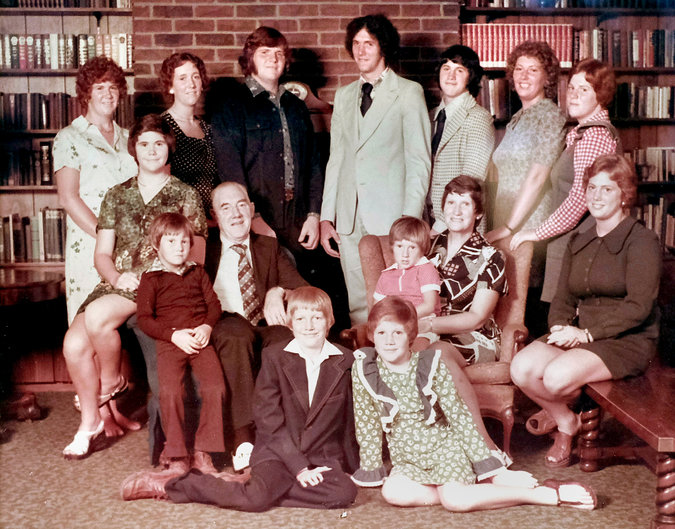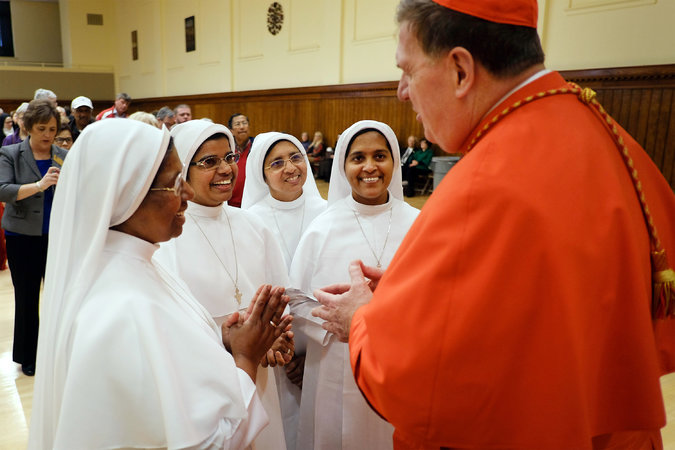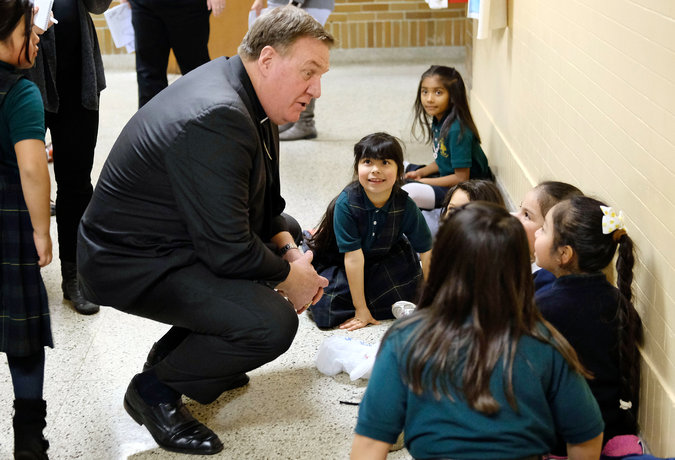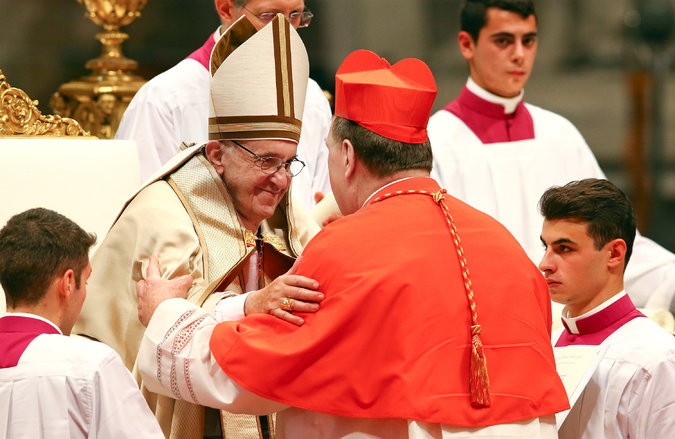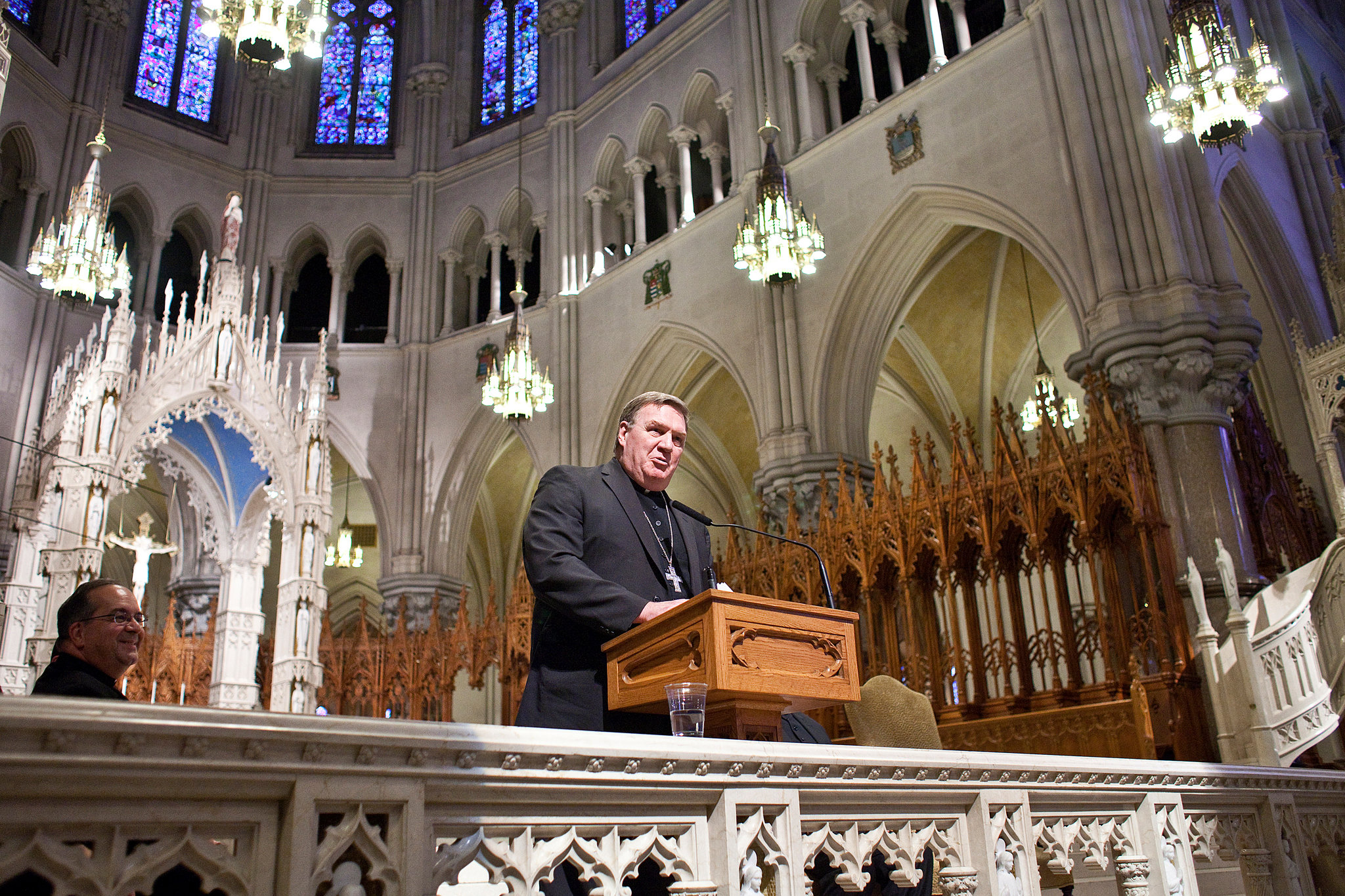Coming to Newark Archdiocese: a Different Kind of Cardinal
By Sharon Otterman
For about a year, the guys at the gym just called him Joe. He lifted weights in the early mornings wearing a skull-printed do-rag. He worked out on the elliptical, wiping it down when he was done. Then one day Shaun Yeary, a salesman at a landscape supply company, asked him in the locker room what he did for a living. “I used to be a priest,” Joe recalled telling him. “And now,” he said, his voice growing quieter so as not to scare anyone in earshot, “I’m the archbishop of Indianapolis.” “I was like, for real?” Mr. Yeary recalled. “This guy is benching two and a quarter!” — gymspeak for 225 pounds. Joe, also known as Cardinal Joseph W. Tobin, recently became one of the 120 men in the world who will choose the next pope. But he wants to be judged by his actions, not his lofty position in the Roman Catholic Church. Though he has led the Archdiocese of Indianapolis since 2012, a status that usually comes with perks like a driver, he drives himself around in a Chevy Tahoe and helps with the dishes after lunch meetings. He introduces himself simply as Padre Jose to the children at a local Catholic school. He showers and shaves at the Community Healthplex gym like any other member, and calls his workout buddies his Band of Brothers. In short, he is just the kind of leader Pope Francis is elevating to realign the church in the United States with his priorities. As the pope has made clear over the past three years, fancy lifestyles, formality and regal titles like Prince of the Church are out of style for cardinals. So is an emphasis on the divisive issues of abortion and same-sex marriage, even though the church’s underlying position on those issues has not changed. Instead, in the pope’s view, the church should emphasize humility and service to the poor. It should be multicultural, welcoming different styles of worship. It should reach out to other faiths and stand up for immigrants, refugees and nuns.
And that, church experts and members of his flock say, is a close description of the priorities of Cardinal Tobin, who will be heading east just after Christmas to lead the approximately 1.5 million Catholics in the Archdiocese of Newark. He is replacing Archbishop John J. Myers, 75, who preferred to be addressed by the formal title Your Grace, and who achieved notoriety when the church spent some $500,000 to outfit the house he will retire to with an indoor exercise pool and an elevator. Cardinal Tobin’s appointment in October as one of the nation’s 18 cardinals came as a surprise to many, including the man himself. But perhaps it should not have. For what his unassuming bearing does not reveal is that he is no stranger to the corridors of power in the church. He is a friend of Pope Francis. And under Francis’ predecessor, Pope Benedict XVI, he had helped lead the Vatican office that oversees the roughly one million men and women in religious orders around the world. That position did not end so well. It was an open secret that Cardinal Tobin was sent to Indiana as a kind of exile most likely because he questioned an inquiry by his office into supposed doctrinal lapses among the roughly 50,000 nuns in the United States. As he got to know the faithful in the chancery of Indianapolis, he would joke with them about it. “I was kicked out and I’m grateful for it,” the chancellor of the archdiocese, Annette Lentz, recalled his saying about how he turned up on her doorstep. And she would tell him, “Their loss is our gain.” How Cardinal Tobin, 64, an amiable 6-foot-3 Irish-American who likes Bob Seger, plays piano and speaks five languages, went from being the oldest of 13 children living in Detroit to the pinnacle of the global church is a story that bears telling. He grew up in a working-class neighborhood where the big houses were perfect for the large families of Irish, Polish and other Eastern European backgrounds that filled them. The local parish, Holy Redeemer, was run by an order of priests called the Redemptorists, and was unusually large, with 14 Masses each Sunday for up to 20,000 worshipers, he recalled in a Dec. 5 interview. His mother was a public-school teacher who quit her job to raise her brood; nine of her cousins and three of her aunts were nuns. Growing up in a deeply Catholic environment, Cardinal Tobin had two role models: the parish priests and his father, a cost analyst at General Motors who attended 6 a.m. Mass daily. Joe Tobin was a rough-and-tumble child, who once crashed through the back-porch window when he was being chased. But he also learned the deeper lessons taught by the nuns at the parish school. “Joe came home in second grade and said to me, ‘Mom, I need a pair of socks,’” his mother, Marie Tobin, 93, recalled before Cardinal Tobin’s emotional farewell Mass in Indianapolis on Dec. 3. “And I looked at his feet and saw his socks were fine. ‘Mother,’ he said, ‘there’s a boy in my class who has rags around his feet and a safety pin.’”
In 1977, when the cardinal was in seminary in Esopus, N.Y., his father died of a heart attack. By that time, the family had moved across the border to Canada, and his father had been commuting to Michigan. “I idolized my dad,” Cardinal Tobin said. “He was everything I think a man should be. He was strong, he played in the Orange Bowl as a freshman in Boston College. He lost his leg in World War II, so he never played football again. He had a quiet, unpretentious faith. He was chivalrous with women. “And I remember when he died,” he added, “and I was waiting at the seminary for someone to drive me to La Guardia, and one of my teachers came and said, ‘If you can be a man like your father, when they call you Father you will be all right.’ And I suppose I am still trying to do that.” He remains close with his siblings. And in the Redemptorists, an order that requires a vow of poverty and emphasizes missionary outreach, he found a second family. He dreamed of being sent to far-flung locales once he was ordained in 1978. Instead, because he spoke Spanish, he was sent right back to Holy Redeemer, which had a growing Hispanic population. There, he learned about serving the poor. An older priest modeled what was to become a signature of Cardinal Tobin’s ministry: an intense focus on each person. “When he is there and you are talking to him, it’s as if you have known him all your life,” said Bernice Guynn, 89, a parishioner at St. Rita in Indianapolis. From Detroit, he was moved during the AIDS epidemic to Chicago, where he ministered at the bedsides of the dying. The church’s stance against homosexuality was not a barrier to him. “It’s important to be there for people,” he said. By 1991, the higher-ups of his order had taken notice and he was moved to Rome. For 12 years, he led the Redemptorist order, finally traveling the world to missions in more than 70 nations.
In that capacity, he made an impression on Cardinal Joseph Ratzinger, then the Vatican official responsible for enforcing Catholic doctrine. In 2010, five years after Cardinal Ratzinger became Pope Benedict, he offered Father Tobin the title of archbishop and the position of secretary of the Congregation for Institutes of Consecrated Life and Societies of Apostolic Life in the Vatican. Cardinal Tobin recalled that he was painting his mother’s porch in Ontario when he got the call from the Vatican secretary of state. “I turned white and started stuttering,” he said. He did not want the job, he said, but how does one refuse the pope? The office he had been tapped to administer was investigating American nuns for supposedly adopting a “secular mentality” and straying from Catholic orthodoxy. In other words, the nuns were accused of being too liberal, and Cardinal Tobin was to oversee the inquiry. But he had an “extremely positive” view of the nuns, he told The National Catholic Reporter at the time, and he wanted to explain their good works. “My first job, I thought, was to ask, ‘What were people trying to accomplish with this?’” he said this month. But the problem, he came to believe, was structural: the investigation of 55,000 religious women by a tiny staff for the alleged errors of a few. “It made as much sense as an ophthalmologist trying to do cataract surgery standing in center field in Yankee Stadium and pointing his laser gun up at the bleachers,” he said. Two years into his five-year term, his priest secretary surprised him with the news. “We are so sorry you are going,” Cardinal Tobin recalled him saying. “And I said, ‘Really, where am I going?’ And he said, ‘Indianapolis.’” The official news did not come for four months. “It was like death by 1,000 cuts,” he said. When he arrived in Indiana in December 2012, most American Catholics had never heard of him. But to the nuns he was something of a hero. “We thought that he was a tremendous individual,” said Mother Anne Brackmann, the prioress of the Carmelite Monastery in Terre Haute, Ind. “And he was welcomed very, very warmly.” Someone else took note of his dismissal: Cardinal Jorge Bergoglio of Buenos Aires, who would become Pope Francis.
The two men met in 2005 during a synod of bishops in Rome, and they bonded over a shared view of the church. There were conservative bishops in their group who wanted, for example, to ban girls from being altar servers. “I have eight sisters, and at the time, I had nieces who were serving at the altar, and I didn’t see the justification for it,” Cardinal Tobin said. “Bergoglio was on the same page. There are more important things to talk about.” They had also laughed together: Cardinal Tobin recalled telling Cardinal Bergoglio that he had been his mother’s choice for pope that year, because she had read how he picked up after himself and cooked his own food. Still, Cardinal Tobin was surprised to get a note from Cardinal Bergoglio in 2010 wishing him luck in his Vatican position. “He said: ‘I remember our time together, I remember our conversations, and I remember your mother’s good taste. I’m praying for you.’” By the time Cardinal Tobin came to the Vatican in 2013 to receive his pallium — the cowl that would mark his status as the archbishop of Indianapolis — Pope Francis had been elected. He was not sure the new pope would remember him. But Francis again surprised him. “I’ve been praying intensely for you since I heard what happened,” Cardinal Tobin said the pope had told him. What happened next was a kind of rehabilitation. Francis appointed him to the oversight committee of the same Vatican office he had been removed from. Then, in October, came the announcement: The pope was naming him a cardinal. He would be the youngest one in the United States. Cardinal Tobin was shocked. “It’s kind of like you are sleeping in class and all of a sudden the spotlight is on you,” he said. At a news conference last month in Newark, he put it this way: “Sometimes I think Pope Francis sees a lot more in me than I see in myself.”
Cardinal Tobin said he loved his time in Indianapolis, where he visited parishes in 39 counties, ministered to prisoners on death row and baptized about 1,000 new Catholics each Easter. He was up by 4 many mornings to pray before arriving at the gym by 5:30. With the help of a trainer, Shane Moat, he learned how to deadlift 425 pounds. “Big breath, explode, keep it close,” Mr. Moat coached him earlier this month. Cardinal Tobin strained and hoisted the weight to his waist. “You the man!” someone shouted. “No, I’m not,” Cardinal Tobin said after dropping the weight with a bang. That morning, Mr. Yeary, the salesman, presented him with a goodbye gift: a framed photo of the cardinal with his seven workout buddies, whose ages range from 27 to over 70. “Oh, man, that’s wonderful, thank you,” the cardinal said. Then he reverted to his lighthearted tone: “None of those Sopranos are going to mess with me. This is my crew.” Cardinal Tobin has had a hard time saying goodbye. He choked up at his farewell Mass and had only one request of the congregation that had packed the cathedral: Pray for him. But his admirers here and elsewhere are hoping that Cardinal Tobin will become a more public voice for Pope Francis and his priorities. He has already done that once, in a showdown with Gov. Mike Pence of Indiana, a Republican who is now the vice president-elect, over welcoming Syrian refugees. In November 2015, Mr. Pence announced that he would suspend Syrian refugee resettlement programs, citing security fears. Cardinal Tobin felt that was not only illegal, but also immoral. He met with Mr. Pence, discussed his objections and told him he would continue the Catholic Charities resettlement program. A federal court has since overturned the governor’s directive. In an email, Mr. Pence said, “Cardinal Tobin is a personal friend, and I deeply respect his commitment to his faith and his ministry.” While Cardinal Tobin did not tell anyone whom to vote for in the presidential election, he said he was disturbed by appeals to fear during the campaign of Donald J. Trump, particularly his views of refugees and immigrants. Mr. Trump, he said, “was appealing to the dark side of the divisive forces, to the unredeemed part of us.” And while the cardinal believes American democracy will ultimately resist such appeals, “you can’t be too Pollyannish about things.”
In Newark, he said, his first job after his installation on Jan. 6 will be to listen. Encompassing Bergen, Essex, Hudson and Union Counties in northern New Jersey, the archdiocese has pockets of great wealth and poverty, and an array of immigrants so diverse that Mass each Sunday is celebrated in 20 languages. About 30 percent of the parishioners are Hispanic. It is also a community in need of healing. In July, citing the failure of the archdiocese to effectively remove priests accused of sexual abuse from contact with children, the editorial board of The Star-Ledger of Newark called the departure of Archbishop Myers a “true blessing.” “During his 15-year tenure as New Jersey’s highest-ranking Catholic, he protected pedophile priests,” the board said. “He urged his flock to vote based on two issues — abortion and gay marriage — at the threat of being denied Holy Communion.” Jim Goodness, the spokesman for the archdiocese, denied those allegations, saying that Archbishop Myers had permanently removed from ministry some 20 abusive priests and that he had “never threatened to deny Communion to anyone.” Cardinal Tobin will bring a different message. One of his priorities, he said, would be to ensure that the archdiocese is fully compliant with church and criminal protocols on handling sexual abuse allegations. At the Vatican in the late 1990s, the cardinal recalled, it was difficult to convince people that the abuse issue was serious. “I think they just believed it was an American problem,” he said, adding, “I don’t want to make it like I was a great crusader over there, but I did take it seriously.” He later led an effort to establish protocols for abuse claims in his order. Yet the most outspoken American victims group, the Survivors Network of Those Abused by Priests, said that Cardinal Tobin, like the church as a whole, must do more, such as posting the names of all credibly accused priests online. “Certainly there are worse bishops, but that fact should comfort no one,” David Clohessy, the organization’s national director, said. Cardinal Tobin assumes his role in an uneasy time. He said that he hoped to lead with joy and transparency, and that he intended to encourage dialogue to bridge divisions. But he would go further if he believed that policies ran counter to the moral values that Jesus taught. On the threats by President-elect Trump to carry out mass deportations of illegal immigrants, for example, Cardinal Tobin was clear. He recalled how Pope John XXIII, before he became pope, issued false baptismal certificates to help Jews escape the Nazis in World War II. “We have to resist,” he said. “With public statements, and then, you do what you got to do.”
|
.
Any original material on these pages is copyright © BishopAccountability.org 2004. Reproduce freely with attribution.
